MediaWall Archive
A selection of our past projects
On the face of it, MediaWall is a massive piece of technology, but its purpose is to enhance the visitor experience within the architectural space of the Commons building.
Since its debut in 2014, MediaWall has been a place for artists, researchers, and students to explore rich media projects. Collectively, these works represent the breadth of creativity within Bath Spa University.
From our staff and students to our global community of partners and alumni; choreography, dance, environment, filmmaking, photography, painting, drawing, coding and above all collaboration, come to fore whilst the technology recedes into the fabric of the building.
2019
7 January to 1 February 2019
'Light Years: Coast 2019'
Anthony Head and Jeremy Gardiner
Digital video
Light Years: Coast 2019 is the latest incarnation of the continuing collaboration by Anthony Head with landscape painter, Jeremy Gardiner. The work features a virtual gallery created by Anthony Head, showing new paintings by Jeremy in the context of the landscape that the paintings feature. The location for the work is the Jurassic Coast of Dorset, in a region just south west of the town of Swanage. Created using a combination of lidar data, paintings and computer coding, the project flies around the coast painting to painting, in a virtual gallery, with ever changing light.
This particular work is part of Professor Anthony Head's research in to immersive media. As well as the Media Wall version of the project, a version exists in virtual reality as well as an 8k 360 degree video.
Anthony Head is a Professor of Digital Media Art and Design and runs the BA Digital Animation course. His practice as a digital artist features coding and often uses realtime 3D graphics. He creates generative experiences for either screen or large-scale projection. He also is showing a sculptural work in Bath Abbey, iMigration.
-250x469.jpg)
25 March to 5 April 2019
Pavel Prokopic
Digital video
Affective Cinema is a practice research project in film, informed by art cinema and experimental film traditions, and by film theory and philosophy (especially that of Deleuze, Bergson and Barthes). The outcomes of the research are films that combine aspects of cinematic style, nuances of performance (which film has the unique ability to reveal to us) and elements of chance (which film has the unique ability to capture). When all these attributes align in an interesting but unpredictable way, a feeling of meaning can be produced: a moment of cinema that is engaging and captivating without trying to tell a story or communicating something specific or intentional through the film. The research expands the potential of cinema by producing experimental film structures in which this feeling of meaning can be identified, and by testing and developing methods that can lead to its emergence.
The research also seeks to unite the practice and theory in a unique way – bringing the theory directly into the practice through a poetic voice-over. The poetic narration presents these complex ideas in a less rational format, combining with and enhancing the feeling of meaning of the images, rather than merely explaining the research and pinning it down with rational efficacy.
This work was first presented at FACT Liverpool in 2018, and subsequently developed for MediaWall.
-251x470.jpg)
8 to 21 April 2019
Curated by Alan Dunn, Ben Parry and MA Curatorial Practice students, in collaboration with S.J. Buckley (MA Sound Arts)
Much of humanity refuses to accept or take responsibility for human-induced climate change, man-made toxicity and pollution, destruction of ecosystems and biodiversity loss that drive species extinction and threaten all life on earth. In order to radically change our everyday behaviours and patterns of consumption, to energise a new generation and change the balance of power, we first need to learn how to think differently. An Uncertain Forecast is a collection of words to inspire conscious change.
-(1)-250x469.jpg)
6 to 31 May 2019
Brigitta Zics
Coded in Unity
Pachinko Machine is a self-learning algorithmic drawing using rules of a pinball machine. The machine plays the game by itself in an automated setup. During the period of the exhibition the machine optimises its own performance through machine learning algorithm and become increasingly accurate in achieving the winning result. The only obstruction to fulfil the complete learning cycle is beyond the machines’ control, as there is a second intelligence embedded within the machine that aims to obstruct and obfuscate. It is a battle of algorithms.
The work aims to represent the walk of life and although we may be able to control some part it, there is always an element of chance that may destruct and encourages us to stray from our original path.
Brigitta also gave a talk at Bath Spa about her work with Pachinko Machine.
See the project page for further details.
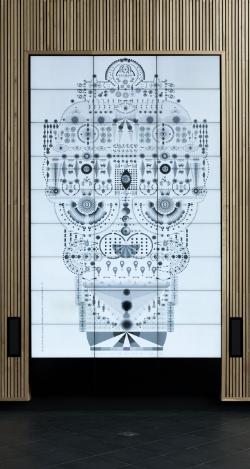
16 July 2019
Rod Dickinson
Coded in Unity
Displayed as part of the Digital Ecologies II:Fiction Machines Symposium.
Fear Filter (2018) is a digital photo artwork by artist Rod Dickinson, comprised of a digital photo stream of user generated images, and a mobile phone photo filters app for Android/iOS. Like comparable photo filter apps such as Flickr and Instagram, the Fear Filter app includes built in filters that can be applied to photos. Rather than offering purely aesthetic adjustments, the filters create a visualisation of the UK Terror Threat Level. Each filter corresponds to a different Terror Threat Level and is generated by gathering current and historical information about the UK Terror Threat Level from the web services of MI5, the UK security service.
Dickinson says, “Fear Filter visualises the underlying anxiety the constant Threat Level creates by making users photos less and less legible as the threat level increases in severity” and “Fear Filter also explores the phenomenon of Security Theatre, where the public and visual impact of security measures often seem more important than actually increasing security”.
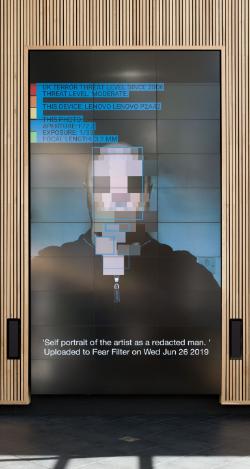
2018
12 to 22 March 2018
'DISPLACED / DISPLAYED: re-enacting dances of migration'
Thomas Kampe and Manuela Jara
Digital video
Displaced/displayed re-activates the legacy of Viennese choreographer Gertrud Bodenwieser (1890–1959) and her dancers within a context of global transmission of dance knowledge through crisis, diaspora and exile. As a Jewish choreographer, Bodenwieser was forced into exile in 1938, via Colombia and New Zealand, to Australia where her work was seminal for the development of Modern Dance culture.
This installation coincides with the 80th anniversary of Bodenwieser’s exile from Europe and celebrates the survival of a nearly lost avant-garde. It builds on artistic research undertaken by Kampe and Brown between 2014 and 2017 (‘Releasing the Archive’, Auckland, Berlin, Hannover, Bath, Tel Aviv and Vienna) in collaboration with The New Zealand Dance Company and international dance-exile scholars and dance organisations.
Drawing on video footage of choreographic work developed through the re-enacting of archival material of ex-Bodenwieser dancers Shona Dunlop-McTavish, Hillary Napier and Hilde Holger, the work explores practices of displacement, doubling and fragmenting of recorded material to echo and honour the labour of lost modernist dancers and dances of exile.
Choreographic Direction and Research: Carol Brown
Sound: Russell Scoones
Video Artist: Meek Zuiderwyk
Video Assistant: Freddie Errazo
The New Zealand Dance Company: Carl Tolentino, Lucy Lynch, Chris Ofanoa, Katie Rudd
Supported through Bath Spa University and University of Auckland.
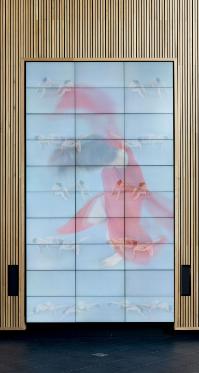
23 to 27 April 2018
'Bath Spa PRIDE'
Laura Steel, Nathan Maradei, George Cook, with help from PRIDE founders Kathryn Jeanes and Kasha-Faye Pascoe
Curated social media feed
Since its founding Bath Spa PRIDE has become one of the most popular student run events on campus, and this year it returns in full force split into four unique events.
As the first PRIDE event in Bath, Bath Spa PRIDE tries to be open to all students based in Bath, and promote a deeper understanding of LGBTQ+ issues and to enable other students to be better allies, but in a fun and entertaining way. We continuously look for ways to evolve and to adapt to make sure the event is open, accessible but keeping LGBTQ+ representation at the forefront of everything we do.
This year, we are bringing the personal sense of PRIDE to the Commons space, allowing students to get involved by using the hashtag #BathSpaPRIDE to be included on MediaWall.
Bath Spa PRIDE is run in collaboration with Bath Spa Student Union.
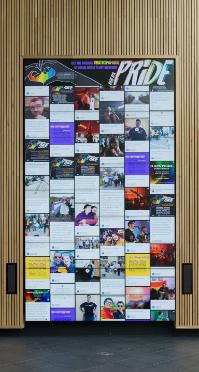
1 to 17 May 2018
'WE ARE ALL...'
MA Curatorial Practice students, with Alan Dunn and Ben Parry
Digital video
With contributors:
Alison, anonymous Newton Park staff, A. Balkin, Beate (domestic service), BORIS, Alison Brice, Fiona Campbell, David Michael Clarke, Nina Edge, Jill Gibbon, hellanwell, Deana Kolencikova, The Laboratory Of Insurrectionary, Imagination, Loraine Leeson, Robert Luzar, MA Fine Art and MA Visual Communication, Misspent Potential, Adam Nankervis, Mariele Neudecker + family, Scott Sandford, Victoria Sharples, Gregory Sholette, The Singh Twins, They Are Here, Mathieu Tremblin, esther tyler-ward / ezra tyler-ward (aged 5), Conor Wilson + family, Zevs.
For further information about the project and accompanying events can be found on the project's website.
In May 1968, the social uprising in Paris began with student occupations of the universities and spread to the factories until the whole country came to a standstill. Fifty years on, MA Curatorial Practice students, Course Leader Ben Parry and guest artist Alan Dunn have created a 60-minute animation that reworks original 1968 protest slogans and again combines the voices of artists, art students and those who work in the Newton Park campus.
4 to 15 June 2018
'Medusa Emergent'
Misha Penton
Digital video
As part a multi-disciplinary project encompassing video, sound, performance and writing, Misha Penton's Medusa Emergent is a work that responds to and is inspired by the formidable snake-haired Gorgon of Greek myth.
You can find out more about the project on Misha's website and on our featured project page.
19 to 27 June 2018
'To Be Watched While Eating an Orange'
Cathy Nicola (dancer), musician Jeff Boehm, and screendance artist Chris Lewis-Smith
Digital Video
Part of the Dance Screen Space symposium
This project, a collaboration between Bath Spa's Chris Lewis-Smith and Jeff Boehm, is a screen exploration in visual storytelling.
Combining film and dance with unfolding narratives across different perspectives, this project seeks to explore the shifts in time that occur when you disrupt and expand the spectator's viewing experience.
Find out more on our featured project page.
28 June to 15 July 2018
'Nurture (3)'
Dan Allen
Digital video
Nurture is the concluding case study (of 6) of Dan Allen’s PhD by practice, which explores the relationship between viewer, viewed, and artist in the interpretation of figurative artwork.
Research investigates how adjusting the hierarchical relationship between viewer, viewed and artist can enhance the level and intensity of viewer engagement.
In recognition of the numerous ingredients integral to an artwork’s interpretation, such experiments have explored the significance of:
- Material and process (and the associations inherent in a material)
- The significance of memory (particularly childhood in shaping how we respond to objects)
- The relationship between our lived body and objects (as laid out through Phenomenological theories)
- The significance of site (and its relation to objects)
- Object relations theory (and the use of metaphor as replacement).
In this conclusive piece of work, the performance and the created object play key supporting roles by establishing the video as outcome. ‘Nurture’ emulates the capacity to draw from personal experience, it recognises the importance of theatre and makes reference to it, it establishes a personal narrative, celebrates the behavioural characteristics of the clay material and draws on the capacity of performance to establish emotive narrative. The use of video as medium enables the dialogue between viewer and viewed to be indefinite.
16 July to 30 August 2018
'WoodWall'
Neil Glen
Digital image
MediaWall is part of the fabric of Commons building and requires a presence at all times. Even if there is no artwork it was important to communicate it's absence, to infer the content is missing. The early history of television included the transmission of a test card, content to reassure the viewer that the technology was working is the absence of a broadcast programme. A black screen is more ominous, suggestive of failure. WoodWall provides this reassurance but also plays with the architecture of the building, extending this into the virtual space of the screens and blurring the boundary.
WoodWall is derived from a digital image of the surrounding wood panelling in the atrium space. The image is edited and cropped to replicate, at 1:1 scale, the repeating pattern of the wooden slats and black cloth. The image tiles and repeats to fill the entire screen space.
Previously used intermittently between works, WoodWall is featured as a project in its own right.
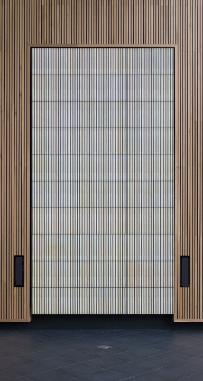
29 October to 22 November 2018
'Dominion'
Lawrence Bird
Digital video
Using the 1871 Dominion Land Survey and Google Earth's modern incarnation as its guide, artist Lawrence Bird's Dominion explores what happens when cartographic projects fail to deliver.
Find out more on our featured project page.
26 November to 17 December 2018
'Rethinking Disposability'
Ben Parry
Digital video
Every day, the city of Mumbai produces over 10,000 tons of waste. The 13th Compound, the city’s main recycling hub situated in Dharavi is responsible for recycling 80% of city’s domestic waste where up to 300,000 rag-pickers supply over 40,000 people employed in grassroots recycling micro-enterprises, working in risky and unsanitary conditions.
Rethinking disposability attempts to challenge received notions of disposable products and materials, exploring issues of work, waste and survival in the 21st Century. India’s complex struggle with managing waste and sanitation and its claims of ‘modernization’ are undermined by images of public squalor in slums. Alongside this, a long tradition of repair/mending, and jugaad (‘frugal innovation’) contrast sharply with the logics of consumerism and social exclusion, which means that material cultures and inequalities are foregrounded in public debates over waste and disposability.
The negative perception and marginalisation of informal labour, in particular the social class of those handling waste materials and human sanitation follow a logic of human disposability, where those bodies, consumed, spent, also take the form of waste. The vital contribution made by informal waste recovery through the self-organised recycling sector remains undervalued and largely invisible, echoing the marginalized and disposable status of the extremely poor workers that sustain it.
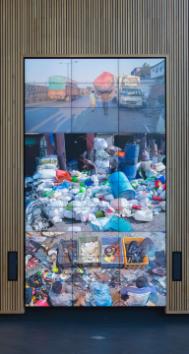
2017
1 to 10 March 2017
'What does feminism mean to you?'
Shona Galloway (BA Creative Media Practice)
Digital photograph
For too long, the word ‘feminism’ has been negatively associated with men-hating or female superiority. Because of this, only 7% of the population of Britain will identify themselves as feminist, despite sharing the same views about gender equality.
These photos for MediaWall focus on what feminism really stands for, and what the word means for other feminists in the community. The aim of the display is to spread awareness about the true meaning of feminism to the students, staff and visitors of Bath Spa University leading up to International Women’s Day on March 8th 2017.
MediaWall displays the statements of these women boldly and brightly for everyone to see. Their words simplify down the core elements of what feminism stands for, in an attempt to make people realise that they can start calling themselves a feminist and believe it.
The varying environments these women are captured in show how feminism is for all. Whether it’s a student in a library, a member of staff at work or the Vice-Chancellor of Bath Spa University, one thing remains constant and that is their support for feminism leading the fight for equality.
27 March to 2 April 2017
'PRIDE'
Kathryn Jeanes
Aggregated curated live social media content
Bath Spa PRIDE is a student-led event in its third year at Bath Spa. Run by Kathryn Jeanes in collaboration with the Students’ Union, the event aims to create an LGBTQ+ safe space that is fun and open to allies too.
As the only PRIDE event in Bath for the past 3 years, Bath Spa PRIDE tries to be open to all students based in Bath, and promote a deeper understanding of LGBTQ+ issues and to enable other students to be better allies, but in a fun and entertaining way. We continuously look for ways to evolve and to adapt to make sure the event is open, accessible but keeping LGBTQ+ representation at the forefront of everything we do.
This year, we are bringing the personal sense of PRIDE to the Commons space, allowing students to get involved by using the hashtags #BSUPRIDE #BSUPride17 or #BathSpaPRIDE to be included on MediaWall.
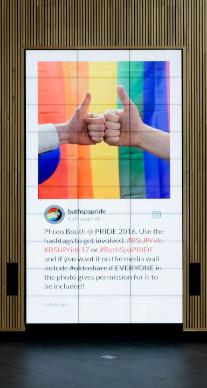
8 to 10 May 2017
'Hidden Collections'
Rebecca Durbin
MA Curatorial Practice
Stop-motion digital video
Hidden Collections uses new media to promote artworks within Bath Spa University with the hopes to engage a new audience that can enjoy the art collection that is right in front of them. The idea for this project came from wanting to spread awareness of an interesting collection of artworks across different campuses to reach more students.
Hidden Collections uses a stop-motion video to act as a digital map and show the journey from the Newton Park Campus to the Corsham Court campus, where the majority of the Bath Spa Art collection is held. The Bath Spa Art collection is undergoing change with a new collections officer in place and is a wonderful moment of transition, which will soon see the collection becoming an asset to the university.
This project captures the collection in its current state but also looks to the future where more students and staff will benefit and enjoy the collection.
11 May 2017
'Rainbow on the Asphalt'
Karen Alonso and Camilo Villota: MSc Creative Technologies and Enterprise and MA Visual Communication
Processing
Pasto Sensorial Project aims to digitally recreate "The Blacks' and Whites' Carnival" (B&W Carnival) one of the masterpieces of the Intangible Heritage of the Humanity. The carnival takes place in San Juan de Pasto (Colombia), which is known as the Surprise City.
'Rainbow on the Asphalt' encourages the Bath Spa University community to be involved in the experience of this festive Carnival through expressing thoughts through artistic skills on the floor, same as people do in Colombia during the celebration of the first day of the Carnival. Through the website you can create an avatar, download your creation and share it on the social media with the hashtag #pastosensorial to see it featured on MediaWall.
18 to 19 May 2017
'BeBods at Bath Spa'
William Thatcher and Angus Allen: BA Creative Computing
Processing
The aim of Bebods at Bath Spa is to connect the university community to the great work happening at Complete Control, a double BAFTA winning children’s interactive production company based just around the corner in Corston. Bebods are the new ‘go anywhere – digital first’ brand for children’s personalisation, creativity and safe self-expression.
Creative Computing students William Thatcher and Angus Allen have been working with Complete Control to find ways of making 3D versions of Bebod avatars. These models, created using additive printing techniques, feature as part of a MediaWall installation that invites BSU students, staff and visitors to be part of the project.
3D Bebod models are scattered around Newton Park campus for you to find and take pictures with. Send us your picture via the Twitter handle @BebodsBSU to have them posted to MediaWall. These sit alongside Bebods created by the Bath Spa community using Complete Control's Bebod Maker. We encourage you to create a Bebod yourself by visiting us in Commons Atrium - the best Bebod will be 3D printed for the owner to keep!
15 to 17 May 2017
'Deconstruction'
Artistic Director: Manuela Jara (MA Dance)
Sound: Robin Mcgovern (MMus Creative Sound and Media Technology)
Curator: Amy Navarrete (MA Curatorial Practice)
Performers: Manuela Jara, Wina Lewis, Yifei Liu, Stacey Pepworth, Stephanie Scheubeck
Digital Video
“When we put dance on screen we lose the liveness of the performance, the flesh and bones, therefore there is a dematerialisation of the body.” - Anna Heighway
Deconstruction, a project between MA Dance and MA Curatorial Practice has emerged from a desire to exchange knowledge and practices between different fields.
The project is a site-specific work created for MediaWall. It takes advantage of the infinite possibilities that the divisions of the screen allow for in the creation of a screen dance. These divisions invite the viewer to explore the concept of deconstruction of the body.
5 to 12 June 2017
'We Record Ourselves'
Simon Ellis, Katrina McPherson, Owa Barua and Natalia Barua
Digital video 30 screen loop (8mins/stereo)
In 1997 film-maker Katrina McPherson tried to get a film commissioned about the largely overlooked work and life of dancer and choreographer Margaret Morris. That film was never made. Nearly twenty years later, Katrina was commissioned to respond to the Margaret Morris archive and invited three fellow dance film-makers to join her - We Record Ourselves was the result.
The project seeks to entangle technological and corporeal mediated presences in order to imagine and display a screen-based embodied archive. This is a new version of We Record Ourselves specially edited for MediaWall for the MeCCSA (Media, Communication and Cultural Studies Association) Practice Network Annual Symposium. The edit sustains the key themes of the original versions (remembering, forgetting, archives and dance) while exploring the possibilities of the scale of the MediaWall and the transient nature of its audiences.
Originally commissioned by Horsecross Arts for Threshold artspace, and acquired for the Horsecross Arts collection of contemporary art. Premiered as part of Movement exhibition, 15 Oct 2016 – 15 Jan 2017 at Threshold artspace, Perth Concert Hall, Scotland. Movement: an homage to Margaret Morris in drama, dance, music and film; curated by Iliyana Nedkova and Wendy Timmons. Supported by C-DaRE (Centre for Dance Research), Coventry University and Creative Scotland.
12 to 29 June 2017
'A Game of Jug'
Conor Wilson
Drawing, collage and digital artwork
Dr Conor Wilson recently completed a PhD research project (Writing_Making: Object as body, language and material, RCA, 2016) through which, influenced by Object Oriented Ontology, he explored craft making as an intimate engagement with, or a form of contact with, another object.
Working methods were developed that exploit the potential of making as a means of generating writing and the potential of writing to generate, or to contaminate, making; methods designed to bring writing closer to making, driven by (and resulting in) questions such as: Can making function as a model, or a spur, for settling deeper into inter-object relations? What voices might emerge from such relations and how might the various objects [maker, material, image, language] that cohere around the activity of making be presented? How might maker, and audience, become an object among objects and access the subjectivity of the material / artwork?
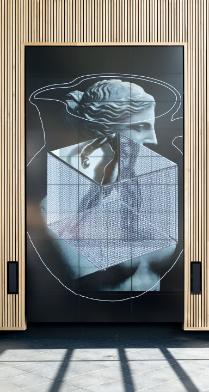
14 to 15 October 2017
'Monument Valley II'
Matt Miller/UsTwo (collage by Neil Glen)
Video sequence of computer game
It may seem like a rather confusing melange of digital agency, game studio, incubator, and venture fund, but for co-founder Matt Miller, UsTwo is a place for having fun above all else.
His company UsTwo has recently found itself in the global spotlight, collecting praise and awards for creating the hugely popular mobile game Monument Valley. With 250 employees and branches around the world, Matt is trying to strike a balance between leading a successful global business and preserving the jolly casualness and genuine friendship that make up the unique fabric of his ‘fampany’.
installed a multi-screen instance of the video, making use of the geometric form of the game to create a repeating pattern. This is very much in the spirit of MediaWall since the outcome builds upon the graphic of the game but it becomes an artwork in its own right.
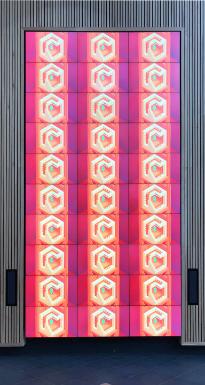
18 October to 16 November 2017
'BSU Global Citizenship and African Initiatives Project'
Photographer: Philip Field
Digital photography
The work featured in this project on MediaWall was also published by the Royal Photographic Society in their May 2017 journal.
19 November to 1 December 2017
'Sitting on the Man'
Onyeka Igwe
Digital video
Traditionally, women in Igbo speaking parts of Nigeria came together to protest the behaviour of men by sitting on or making war on them. This involved ‘gathering at his compound, sometimes late at night, dancing, singing scurrilous songs which detailed the women’s grievances [with]… the head wreathed with young ferns [which] symbolized war, and sticks, bound with ferns or young palms…used to invoke the powers of the female ancestors.’*
This practice became infamous due to its prominence as a tactic in the Aba Women’s War, the 1929 all woman protest against colonial rule. This work revisits this practice by engaging contemporary dancers in its reimagining, drawing on both archival research and their own experience.
Commission for FAM (Filming African Music) Symposium.
Project included a live performance of MediaWall film (Onyeka Igwe) with dance improvisation (Ripton Lindsay)
*Judith van Allen,"Sitting on a Man": Colonialism and the Lost Political Institutions of Igbo Women, Canadian Journal of African Studies, 6.2 No. 2 (Special Issue: The Roles of African Women: Past, Present and Future, 1972), pp. 170.
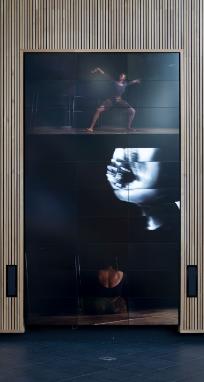
4 December 2017 to 2 February 2018
'Flow Series 1 - 4'
Anthony Head
Coded in Processing
Flow is a generative artwork series shown over a period of months on MediaWall. It features a number of different particle based computer-coded artworks, originally inspired by simulating nature.
Each artwork in the series is generated in real-time and hence never repeats itself. There were four different versions of flow, including one that was sound responsive and one that used stereo 3D graphics to create a flowing 3D sculptural form that came out of the large wall of screens into the space.
Further information on the Anthony Head website.
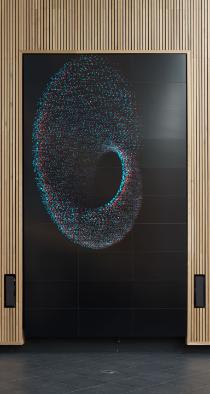
"The most profound technologies are those that disappear. They weave themselves into the fabric of everyday life until they are indistinguishable from it."
Mark Weiser - Chief scientist, Xerox PARC
2016
9 March to 10 April 2015
'Social Reading Experiment'
Year 3 UG English Literature and Publishing students
Curated Twitter feed
Students have adapted three of their set texts on Twitter: Robin Sloan's Mr Penumbra's 24-Hour Bookstore; Margaret Atwood's Maddaddam; and John Buchan's The 39 Steps. Using a range of techniques, students are encouraging participation from staff and students of the university and from outside. You can join in using the following hashtags, and follow these on Twitter to see responses. All tweets will be displayed on MediaWall throughout the week.
18 to 31 January 2016
'Fluid Data'
Kelly Thompson
High-resolution digital scan of woven textile
You can read more about this work on our project page.
Invisible digital systems surround us, at sea and on land, in the tools we depend on and like to use. Materialising the digital suggests a drawing attention to the power of multiple systems, and also to the potential of abuse, overload or failure of what we rely on. The imagery in Fluid Data layers found and manipulated data files, error messages, symbols and codes of digital tracking, maps of global undersea internet cables routes, graphs of climate data all connected through the subtle imagery of water. Periodically data is “missing” resulting in deliberately unwoven sections, conceptual visual glitches, or shifts in the control and order of the woven structure resulting in the unexpected.
Each side of the six jacquard fabric panels provides details and layers of translation, communication and readability. Woven on a digital jacquard loom (a precursor to computers) the weavings are digitised, with the pieces enlarged 10x for MediaWall, in a slideshow that adds a further looping or flow of information. Pixels are both threads and digital moments, inviting a close and distant view of content.
Thompson’s artistic work draws from her experience of living and travelling widely, and often utilises mapping concepts, or visually represents open waters and the borders between land, sea or river, as markers of transitory moments of time, place, body and memory. Recent projects address everyday ephemeral traces, language, translation and the manipulation of data in punch card and digital jacquard weaving.
Funded by Le Fonds de recherche du Québec - Société et culture (FRQSC), and thanks to Hexagram and Concordia University's Textile and Materiality Research Cluster.
4 to 9 February 2016
'Forced Walks: Honouring Esther'
Richard White and Lorna Brunstein
Google maps and ViewRanger
You can read more about this work on our project page.
“We walk at a time and place of our choosing in solidarity with those who had no choice.”
A two-day artist-led walk-in-witness, 4 and 5 February, from the site of the slave labour camp, Judenlager “Waldeslust” in Hambuhren, Ovelgönne to the Bergen Belsen Memorial Museum, the 71st anniversary of the death march.
Forced Walks: Honouring Esther is working with the testimony of the Yiddish actor, Bundist and anti-fascist activist, Esther Brunstein. In August 1944 Esther was transported from Auschwitz with a group of Polish Jewish women to the slave labour camp at Hambuhren, Ovelgönne. On the 4th February 1945, the camp was cleared, those who survived were forced to walk to Bergen-Belsen camp. She was liberated from Bergen-Belsen to Sweden later in 1945.
Inspired by Esther’s story and her spirit of resistance, artists Richard White and Lorna Brunstein, Esther’s daughter, weave testimony, poetry and reflection through a 2 day journey generating further historic and contemporary human rights resonances. The walk takes the format of a secular pilgrimage with a series of themed stopping points, ‘stations’. At each ‘station’ walkers will pause to listen, record their thoughts, bear witness and share with the world. The artists offer an open invitation to participate in the project on foot or online.
- Thursday 4 Feb 2016: Walkers assemble at 10.00 at the site of the slave labour camp, Judenlager Waldeslust in Hambuhren, Ovelgönne.
- 5 ‘stations’ between Ovelgönne and Winsen an der Aller: Bearing Witness; Inheritance; Justice; Slavery; Resistance
- Friday 5 Feb 2016: Walkers assemble at 09.00 in central Winsen where there is a memorial to the death march that passed through here in April 1945.
- 5 ‘stations’ between Winsen an der Aller and Belsen: Audio testimonies Indifference; Exile; Belonging; Hope; Liberation.
MediaWall will be showing a live map, updated during the walk on Thursday and Friday. Richard's location will be tracked and, using social media, will display text and images from the walk. Audio testimonies are replayed when the walk reaches each of the 'stations'.
4 to 9 February 2016
'A Gift for Eleonora'
Sandra Porter
Scanned artworks, sequenced in PowerPoint by Neil Glen
‘A Gift for Eleonora’ was first performed in Florence at the Pazzi Chapel in May 2015. Eleonora De Toledo was a remarkable woman who married into the Medici dynasty, and was the first Duchess of Florence in Renaissance Italy.
The next performance will take place at The Roman Baths, on Thursday 3rd March. MediaWall is part of a work, which draws upon the life story of Eleonora de Toledo as realised in the performance, the design and structure of the costume and the architecture of the two venues. Taken from photographs of the first performance and the two venues, the work offers an interdisciplinary approach to ‘drawing’, ‘observing’ and ‘animating’ performance, together with ‘process’, ‘creation’ and ‘development’. Incorporating images of work by Sandra Porter, already influenced greatly by the art & architecture of Renaissance Italy, visual metaphors have been created for the physical and emotional in order to make the work for the wall.
Devised, written and performed by Alison Oddey
Designed, produced and performed by Chris White
With music composed and performed by Nick Sorensen
Costume Design by Tim Heywood
Photography by Chris White
Photography, drawing, printmaking and presentation by Sandra Porter
9 to 10 April 2016
'Resounding Mulgrave'
Robert Mackey, Tariq Emam, John Wedgwood-Clarke
Digital video
Resounding Mulgrave explores the post-industrial landscape of Port Mulgrave, north of Scarborough, UK. It was one of three artistic interventions exploring and reinterpreting the Rotunda Museum, Scarborough (created by the father of modern Geology, William Smith). It was commissioned by Scarborough Museums Trust as part of the Dictionary Stone project curated by Lara Goodband, and supported by Arts Council, England.
The work was a collaboration between poet John Wedgwood Clarke and sound artist Rob Mackay, with technical and artistic support from Tariq Emam (video/performance).
‘There’s a fossil shell by my foot the colour and texture of grey opaque glass, perfectly moulded, complete with a scallop’s bow and ridges. Right next to it, but 183 million years later, there’s a limpet. The gap in time between the two doesn’t seem to exist, but I know that it does.’ - John Wedgwood Clarke
This awareness of the silent, pre-human gap between our present and geological past motivated our exploration of the coast between Port Mulgrave and Staithes. We used words and sound, both found and structured, to play within this silence and make connections between the ‘pastoral’, the ‘sublime’, and the history that has flowed from the smelting of the ironstone for which this stretch of the North Yorkshire coast is geologically famous.
In collaboration with the Seeing Sound conference.
11 to 18 April 2016
'Two Space 2009 (MediaWall)'
Larry Cuba
Single HD video loop, tiled and sequenced using Dexon controller by Neil Glen
Two-dimensional patterns, like the tile patterns of Islamic temples, are generated by performing a set of symmetry operations (translations, rotations, and reflections) upon a basic figure or tile.
Two Space consists of twelve such patterns produced using each of nine different animating figures (12 x 9 = 108 total). Rendered in stark black and white, the patterns produce optical illusions of figure-ground reversal and after images of colour. Gamelan music from the classical tradition of Java adds to the mesmerising effect.
Two Space was originally produced in 1979 as a 16mm film, using a DEC PDP-10 mainframe computer and a vector graphics film plotter. In 2009, on its 30th anniversary, Two Space was digitised and its soundtrack upgraded to high fidelity stereo.
This unique edition for MediaWall sequences and tiles the 2009 film across 30 HD screens as a single high resolution moving image 10,800 pixels high.
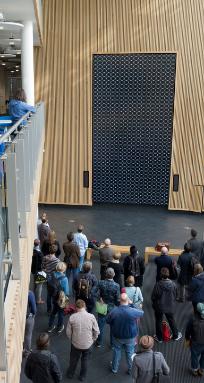
6 to 19 June 2016
'Forest Portals'
Neil Glen
Digital images
Augmented reality overlays digitally mediated information onto the real world. Visual cues, such as doors, become triggers to display content via a mobile device.
For Forest of Imagination, Neil created a trail of information, in which the participant discovers real and imaginary forests through specially selected doors, Forest Portals, around Bath Abbey. Each portal offering a glimpse into a beautiful, enchanting places including Madagascar’s Spiny Forests & underwater Kelp forests in the Pacific Ocean. Research by Nigel Chaffey, Course Leader Environmental Science at Bath Spa tells us why we need to look after these special places.
For MediaWall Neil has taken detailed photographs of these architectural spaces and presented them at full size, allowing you to explore them using augmented reality in the same way as you would explore the real architecture. This is the first stage of Neil’s work as part of Elastic 3D Space; a research project with Concordia University in Canada.
15 to 24 July 2016
'Mondrisonic'
Tim Sayer and Andy Visser
Processing
Tim Sayer and Andy Visser from the University of St Mark and St John Plymouth have been undertaking research in the area of biofeedback and human-computer interface design in the context of musical improvisation.
Mondrisonic is the first work created using an animated graphic score system which is responsive to an EEG signal from a ‘brain performer’ as they are stimulated by the improvisation of an instrumentalist. This creates a curious feedback loop where the instrumentalist is responding to a graphic score which in-turn is being manipulated by the brain activity of someone who is listening to a combination of the sounds generated by the score and the instrumentalist. The crux of the interaction is the level of focused attention the ‘brain performer’ affords to the sounds generated during the performance either by the software algorithms or the human instrumentalist.
Mondrisince was first performed live on 14th June as part of Performance Studies Network 2016, inspired by the paintings of Piet Mondrian, with Tim as ‘brain performer’ using the EEG headset and Andy as instrumentalist playing Bass Clarinet.
MediaWall subsequently showed a re-creation of the live performance, in the absence of a live performer the EEG data is simulated by the software and aligned with the audio track of the bass clarinet.
3 to 11 and 14 to 20 October 2016
'Pretty Abstract'
Paul Minott
Adobe CC
Paul Minott's 'Pretty Abstract' is an exploration of abstraction that sits at the crossover of art and design. It is influenced by 20th-century abstract painting and Modernist design. The images on MediaWall are from a triptych created by Minott using digital technologies and his knowledge of and sensitivity to the juxtaposition of colour, form and text.
Minott has used a special method combining digital precision to create shapes, with the chance outcome of the etching press. This has led to geometric shapes that are carefully composed to explore contrasting and complementary colour.
The final hand printed stage of this work is on show at Main Gallery, Black Swan Arts, Frome until 8th October after which the work will move to the Affordable Art Fair, Battersea, London from 19th to 23rd October.
24 October to 2 November 2016
'Reads and Rights'
Bath Spa University Library project team (Alison Baud, Hazel Grainger, Melissa Newall and Katharine Wojcik)
supported by Neil Glen; Lee Scott and the BA Acting students.
Infographics and iPad coded in HTML5 / Information display units CNC machined plywood
Books have the power to shape people’s ideas and beliefs. Through them we glimpse lives, share feelings and experience worlds beyond our own. In October 2015, the librarians at Bath Spa University embarked on an exciting and innovative outreach project to stimulate community engagement and act as a platform to celebrate libraries as diverse, inclusive and democratic spaces. The aim of the Reads and Rights campaign was to encourage thinking, reading, writing, and debate around the theme of equality and diversity.
Staff and students were prompted to get involved in the conversation by responding to one question.
“Thinking about equality and diversity, which books or people do you feel have been most influential in changing attitudes and beliefs in society or have had an impact on you personally?”
All the suggestions have been captured and transformed into a visually striking digital timeline, which aims to contextualise key thinkers and writers over the centuries.
The project draws to a close with an interactive multi-media installation during the University’s second annual Celebrating Equality week from 24th to 28th October 2016.
MediaWall features an animated 3D version of the Reads and Rights timeline and highlights different themes (LGBTQ*; Disability; Gender; Mental Health; and Race) during the course of the week. Short extracts from selected books, read by undergraduate students from the University’s BA Acting course, augment the visual information displayed on bespoke plinths in the atrium. Visitors can engage by responding to questions designed to stimulate thought, debate, and discussion through touch-screens encapsulated in each plinth which capture responses throughout the week summarised with real-time infographics on MediaWall.
28 November to 14 December 2016
'Sphere House 3D Visualisation'
Anthony Head
Unity
A 3D visualisation of 30 minute section of experimental sensor and camera data recorded in October 2015. SPHERE (a Sensor Platform for HEalthcare in a Residential Environment) is a five year, £15 million project funded by Engineering and Physical Sciences Research Council researching low cost methods of monitoring health of people in their homes.
The project was launched with Universities of Bristol, Reading, Southampton and is developing sensor systems that can be installed in people’s homes in order to gather data about their activities that can be interpreted into health management. The aim is that this research can lead to effective monitoring of the health of residents, to prevent accidents, reduce illness and improve recovery and care. Ultimately the research could lead to a healthier society and billions of pounds of savings for the NHS.
SPHERE has several university research partners and Bath Spa University’s Anthony Head has been working with the project on data visualisation, creating a 3D model of the model of a standard two bedroom terrace house in Bristol that is being used as the experimental laboratory for the SPHERE experiments. In this house sensors (such as door, temperature, electricity, water flow, infra-red, humidity) have been positioned in rooms in the house, and actor/researchers carry out scripted activities to observe and analyse the data recorded. Additionally, three rooms in the house have a video camera recording the position of the person in those rooms (kitchen, hallway, lounge). Head has added visualisation methods to these data elements (the numbers are shown on the left) to show the data in real time.
The visualisation shows the recorded data for a 30 minute section in October 2015, alongside head mounted camera footage. This approach enables the researchers to establish how well the sensors are recording data, and what meaning can be ascertained from it. The visualisation shows issues with monitoring the position of residents which has since been improved (for example the resident appears to get stuck in the hallway). The visualisation can potentially be developed into a platform that helps residents in the home see and trust the system that is recording them.
In 2017, the SPHERE project will reach the next stage, and be deployed into up to a 100 homes in Bristol. This will enable more robust testing of the engineering needed to facilitate data capture on a larger scale and more unpredictable non-lab situations.
2015
9 March to 10 April 2015
“Lake King William: Every Day of November 2014”'
David Stephenson and Martin Walch
Multiple time-lapse images compiled and sequenced in Processing by Anthony Head
The Derwent Project explored new ways to visualise complex environments, using Tasmania’s Derwent River watershed as a study site. The Derwent is a technologically altered ecosystem that encompasses a remarkable range of environments; arising within the Tasmanian Wilderness World Heritage Area, passing through ten hydroelectric developments before meeting the sea below the port city of Hobart.
The Derwent Time-lapse Array investigates the location through of 12 camera stations dispersed across the Derwent in representative environments ranging from wilderness headwaters to urban estuary. Still photographs are recorded at each camera station every five minutes, 24 hours a day, 365 days a year.
“Lake King William: Every Day of November 2014” displays photographs taken at the highest impoundment of the Derwent hydroelectric scheme. Each one of the 30 screens represent one day in November, displaying photographs taken every five minutes and cycling through a 24 hour day in 24 minutes. At any moment the screens display the same time during each day of November, in which the level of Lake King William recedes with the approach of the Australian summer, a function of seasonal and cyclical variations in inputs (precipitation over the catchment) and outputs (evaporation and releases of water for power generation).
22 April 2015
'Marenje Ensemble'
Amanda Bayley, produced by Neil Glen
Live video feed with effects programmed in Processing by Anthony Head
Marenje is cross-cultural music and dance event performance with world-renowned mbira player, Chartwell Dutiro, Denise Rowe (dance and mbira) and Exeter Contemporary Sounds (string quartet).
27 to 29 April 2015
'playTogether'
Christopher Bingham
Year 2, BA (Hons) Media Communications
Adobe Flash
playTogether is a project centred around music, participation and above all enjoyment. This piece is an opportunity to play in a group of people with the goal of producing music by jumping on pressure pads. The bottom section of the screen serves as an indication system telling participants when to jump on their pad for the best result, and the remainder of the display hosts visual representations of the instruments currently in action.
18 to 26 June 2015
'Marvellous Marble Machine'
Anthony Head
Unity
As part of the Schools without Walls event and the 5x5x5=Creativity conference, Anthony Head worked with Year 4 children from St Andrew's School, Bath, to create a marble machine that features the images and designs of the school children. It covers subject areas including art, design, engineering, physics.
This Marvellous Marble Machine is an infinitely running gravity based machine, powered by 16 balls that are always running down it. It is divided into five themed zones (devised by the school children).
A video of the project is available.
2 to 31 July 2015
'General Intellect'
James Coupe
Digital video sequenced in Python and OpenFrameworks
General Intellect is a multi-channel video installation, first shown at MIX Digital Conference 2015, that generates narratives from video files produced by an online micro-labour force, Amazon’s Mechanical Turk (mTurk) service. Described as “an on-demand, scalable, human workforce to complete jobs that humans can do better than computers,” mTurk allows companies, or “requesters”, to post “Human Intelligence Tasks” (HITs), assignments that typically involve image analysis, online research, and writing. The majority of tasks take around one minute to complete and pay five-to-ten cents. Ultimately, HITs are used to train computers to respond and behave more like humans.
The production of General Intellect involved commissioning mTurk workers to record videos of themselves for 1 minute of every hour between 9am and 5pm, for which they were compensated $3. The resulting videos are portraits of an extraordinary range of people, living conditions, and daily routines, featuring solitary individuals, their families, and their domestic environments. They are a diverse workforce, with representatives from around the globe.
The work is comprised of thirty LCD monitors arranged in a 3 x 10 rectangular formation, a “Media Wall” of eight-hour work days. An algorithm organizes the workers’ videos based on numerous demographic parameters – age, gender, race, location, common keywords/activities, semantic relationships, time of day, etc. The captions from each video are displayed as subtitles. General Intellect asks about the value of digital labour, the shifting conditions of exploitation, and the new forms of social alienation that we face today, alone and together.
General Intellect was subsequently shown at Aktionsart, Seattle.
19 to 23 October 2015
'Lines of Desire: Bringing art and geography together to explore and map Newton Park'
Julieann Worrall Hood, Rebecca Schaaf, Owain Jones
Google Maps and ViewRanger; integration by Richard White
This collaborative and interdisciplinary project aims to explore ways of seeing, interpreting and mapping the Newton Park campus. It is grounded in the work of land artists and psycho-geographers that endeavour to find new ways of engaging with, and understanding, place.
During a one-week intensive experience from 19th to 23rd October 2015, a selected group of Bath Spa University Art and Geography students collaborated to co-create a piece, informed by the approach of Richard Long and other land artists, that embodies aspects of the learned and intuited layers of meaning of the campus in which they are situated.
Using geolocation data combined with social media, MediaWall will display a live mapping of the activities around the campus during the week to form a focal point for student-led discussions about the nature of the landscape and our relationship to it.
The experience and outcomes of the project were presented at Landscaping Change conference at Bath Spa University in March 2016, and also disseminated through a short film made by Bath Spa University students and a published paper, Geography and Art: Encountering Place Across Disciplines.
24 October to 21 November 2015
'Radiant'
Merilyn Fairskye
Digital Video
Merilyn Fairskye engages you through her photographic and video practice which explores notions of time, identity and place. Responding to sites of historical significance, including Chernobyl, Sellafield and The Polygon, Kazakhstan, her work appears both monumental and transient; she gives us pause for reflection on the contemporary challenges faced amid technological advances and globalisation.
Surrounded by secrecy, located in remote environments or hidden away behind signs restricting entry, nuclear sites are vulnerable to fragile security systems, weather, conflicting protocols, political priorities, mismanagement and corruption, and sometimes just simple mistakes. They reflect the flawed optimism of an earlier age and the limitations of the fallible entities that manage them today.
Radiant was shot on location at Sellafield, nuclear fuel reprocessing and decomissioning site near Seascale, Cumbria, UK; The Polygon, decommissioned Soviet nuclear test site, Semipalatinsk, Kazakhstan; Ranger Uranium Mine, Kakadu National Park, NT, Australia, and Dungeness Nuclear Power Station B, Kent, UK.
A video of the project is available.
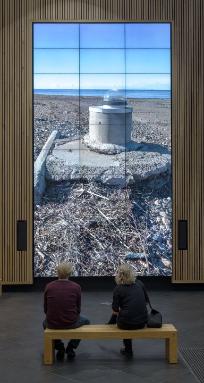
1 December 2015 - 31 January 2016
'Fluid Data'
Kelly Thompson
Digital scan of hand-woven digital jacquard 6 colour tapestry warp, cotton and linen.
You can find out more about this work on our project page.
Invisible digital systems surround us, at sea and on land, in the tools we depend on and like to use. Materializing the digital suggests a drawing attention to the power of multiple systems, and also to the potential of abuse, overload or failure of what we rely on. The imagery in Fluid Data layers found and manipulated data files, error messages, symbols and codes of digital tracking, maps of global undersea internet cables routes, graphs of climate data all connected through the subtle imagery of water. Periodically data is “missing” resulting in deliberately unwoven sections, conceptual visual glitches, or shifts in the control and order of the woven structure resulting in the unexpected.
Each side of the six jacquard fabric panels provides details and layers of translation, communication and readability. Woven on a digital jacquard loom (a precursor to computers) the weavings are digitized, with the pieces enlarged 10x for MediaWall, in a slide show that adds a further looping or flow of information. Pixels are both threads and digital moments, inviting a close and distant view of content.
Thompson’s artistic work draws from her experience of living and travelling widely, and often utilizes mapping concepts, or visually represents open waters and the borders between land, sea or river, as markers of transitory moments of time, place, body and memory. Recent projects address everyday ephemeral traces, language, translation and the manipulation of data in punch card and digital jacquard weaving.
Created by Kelly Thompson as part of the ongoing project Material Codes:Ephemeral Traces, with research assistant Sophia Borowska. With funding from Le Fonds de recherche du Québec - Société et culture (FRQSC), and thanks to Hexagram and Concordia University’s Textile and Materiality Research Cluster.
2014
3 March to 11 April 2014
'Light Years: Coast'
Anthony Head and Jeremy Gardiner
Unity 3D
Light Years: Coast explores the geology of the World Heritage Jurassic Coast through painting and 3D graphics. Landscape painter Jeremy Gardiner and digital artist Anthony Head had worked together over a period of 12 years and converted their 2010 project to work on MediaWall.
The project features an hour-long virtual trip along the coast of Dorset, with weather influenced by real-time weather data. Mixing LIDAR data of the coastal terrain, scans of original paintings, sound and interactivity Light Years: Coast explores time, from the geological time of the rocks to the now time of the weather.
Further info on the project website.
30 April 2014
'Digitrope3'
Anthony Head and Jo Hyde
Live video feed with effects programmed in Processing by Anthony Head
Live performance for Bath Spa University Board of Governors with music students, visuals performed by art & design students.
6 to 22 June 2014
'Lily'
Julian Opie
Continuous computer animation
Highlight of the Commons opening, see the project page.
In association with the Holburne Museum.
7 July to 10 August 2014
'OAK'
Anthony Head, Neil Glen, Tim Vyner, Kate Pullinger
Coded in Processing
OAK is a real-time generated text analysis project that reads each of the letters that have been submitted as text to the Letter to an Unknown Soldier website. It features a hand-painted oak tree, the latest four letters from the public and all of the words analyses so far on the tree, that appear as leaves that fall when they reach a particular popularity. After that they regrow on the tree, hence the tree showing all of the different words that have been written in the letters.
OAK branched out of Letter to an Unknown Soldier, led by Kate Pullinger in collaboration with Neil Bartlett, and part of the 14-18 NOW commissions.
A short video with the collaborators of the OAK project is available to watch.
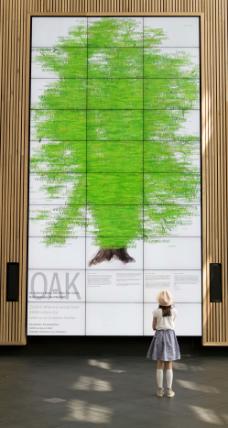
27 October to 2 November 2014
'Atlantic Crossings'
Chris Lewis Smith
Live video feed with effects programmed in Processing by Anthony Head
MediaWall facilitated the culmination of a week-long workshop between 6 postgraduate and 3 undergraduate dance students from Bath Spa University with 9 dancers from Roger Williams University, Rhode Island, USA. The dancers worked with Cardiff based choreographer Jo Fong and Chris Lewis-Smith to construct short dances concluding in performances with music provided by Bath Spa University jazz musicians. Anthony Head created software to stream and re-present the dance sequences, looped, layered and delayed, in a multi-screen layout.
More images on the project's Facebook page.
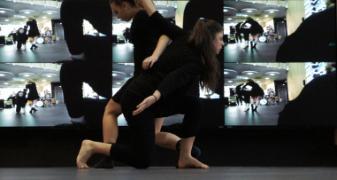
10 to 14 November 2014
'Victor Explains the Mysteries'
Michelle Elliott with Earthfall; produced by Neil Glen
Live video feed with effects programmed in Processing by Anthony Head
Victor Explains the Mysteries was a week-long choreographic residency in Commons offered BSU Dance, Music and Photography students an opportunity to work alongside the award-winning professional dance company Earthfall. The project formed part of a level 5 performance module assessment designed to encourage the students to create substantial work that engages with a range of integrated creative elements.
The project explores the natural, architectural and technical features of the Atrium space, MediaWall and the surrounding building concluding in a performance mixing live and recorded visuals with music and movement to over 120 guests.
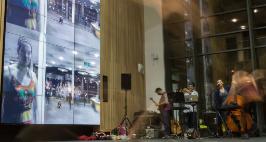
20 November 2014 to 5 February 2015
'Between Worlds 2'
Bruce Munro
Mixed Media (digital animation)
You can find out more about this work on our project page.
Between Worlds is Munro’s first truly digital piece, first shown in December 2014 and inspired by light streaming into the atrium across the MediaWall at Bath Spa University. The wooden verticals of the cladding surrounding the thirty screens inspired Munro to create an abstraction of a forest illuminated with slanted beams of sunlight.